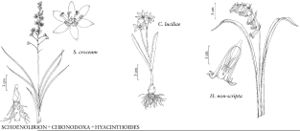Chionodoxa
Diagn. Pl. Orient. 1(5): 61. 1844.
| Taxon | Illustrator ⠉ | |
|---|---|---|
 | Schoenolirion croceum Chionodoxa luciliae Hyacinthoides non-scripta | Yevonn Wilson-Ramsey Yevonn Wilson-Ramsey Yevonn Wilson-Ramsey |
Herbs, perennial, scapose, from tunicate bulbs. Bulbs perennial, ovoid to globose, composed of free scales, progressively renewed annually; tunics brown. Leaves usually 2, basal, erect or spreading. Inflorescences racemose, open, 1–few-flowered; bracts none or 1 subtending each flower. Flowers: perianth blue or blue and white; tepals shortly connate to form urceolate tube, lobes spreading to reflexed; stamens 6; filaments inserted at apex of perianth-tube, unequal, ± equaling anthers; anthers dorsifixed, introrse; ovary superior, 3-locular, septal nectaries present; style simple. Fruits capsular, subglobose, 3-lobed, dehiscence loculicidal. Seeds 3–18, globose to ellipsoid, not winged, elaiosomes present. x = 9.
Distribution
Introduced; e Mediterranean area, 1 or 2 species naturalized in temperate areas
Discussion
Species 6 (1 in the flora).
Chionodoxa, traditionally separated from Scilla because of its partially fused tepals, is very similar to species of Scilla subg. Scilla, especially S. bifolia Linnaeus, and hybrids between species of the two groups (×Chionoscilla allenii Nicholson) occur frequently. As a result, the species of Chionodoxa are sometimes included within Scilla subg. Scilla (F. Speta 1971, 1976).
Selected References
None.
Lower Taxa
"broad" is not a number."thicker" is not a number.